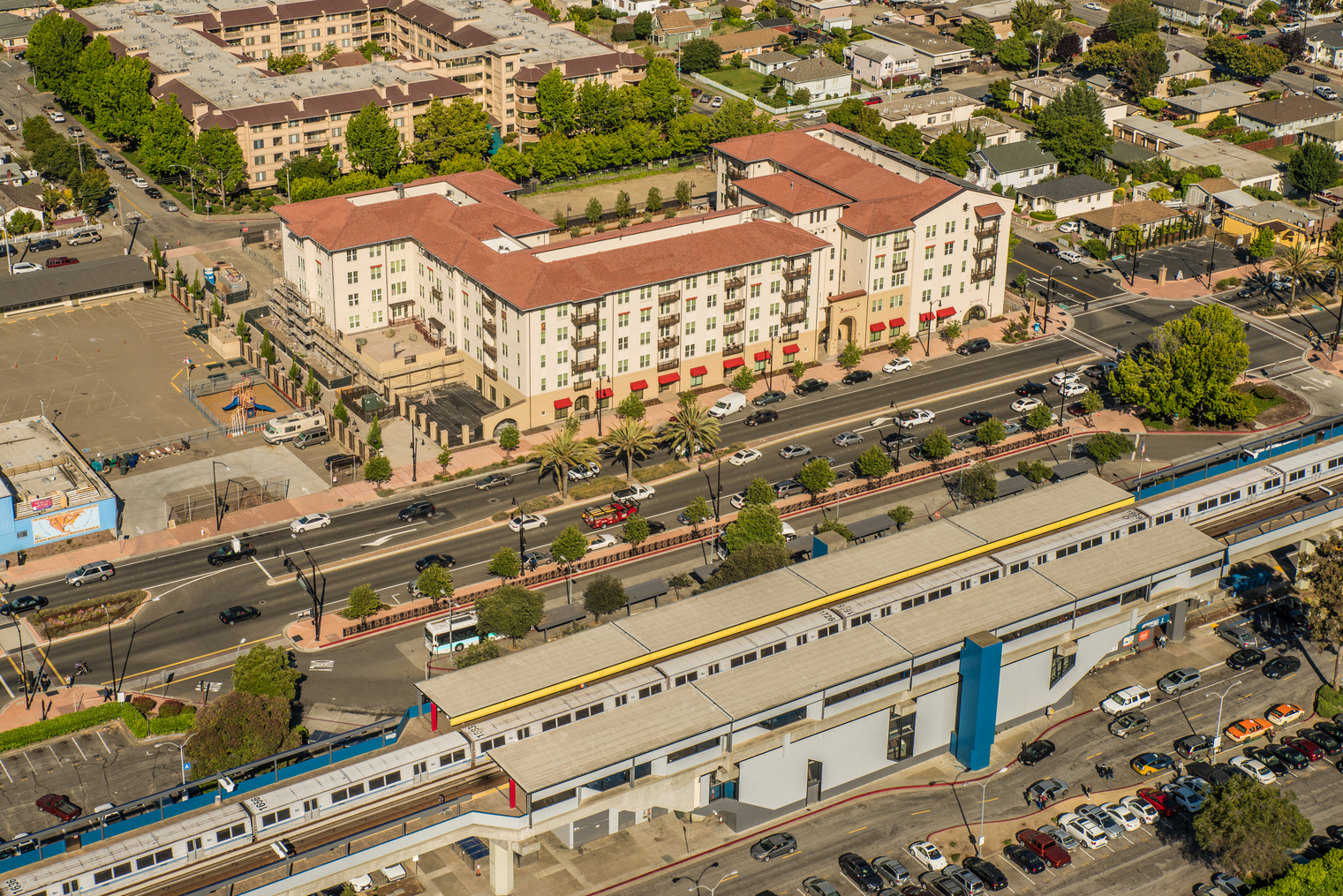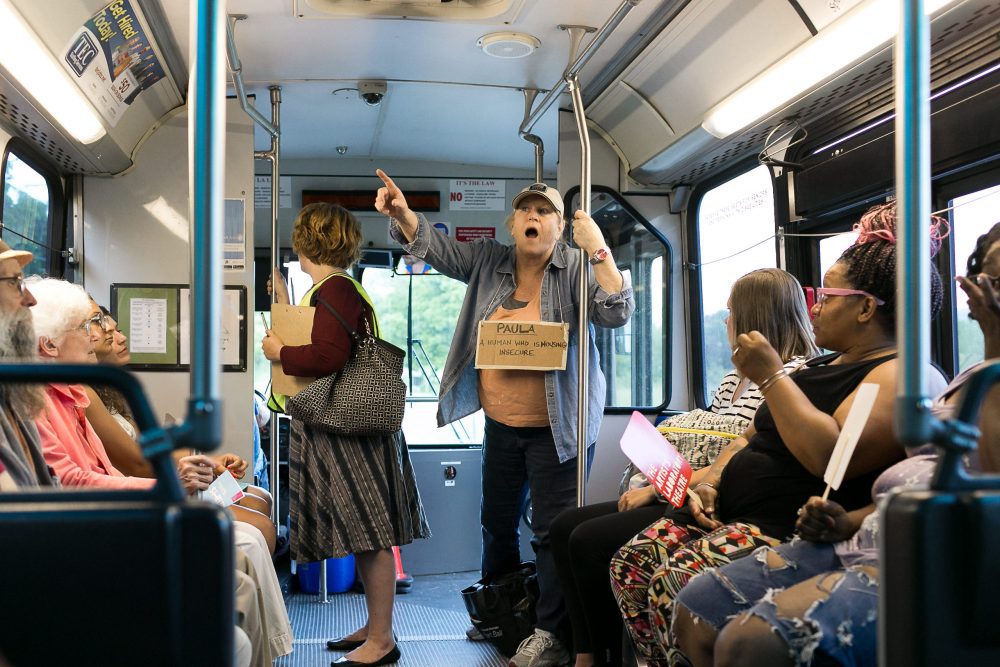In large and small communities across the U.S., rising rents and a chronic housing shortage have made it difficult for working families to make ends meet.
Over the past eight years, housing construction has barely kept pace with household growth. There’s a shortage of affordable homes, too: the number of units nationwide renting for less than $800 fell by 4 million between 2011 and 2017, and in some metropolitan areas, fell by 20 percent, according to the Joint Center for Housing Studies at Harvard University.
Nearly 1 in 3 households (and 47 percent of renter households) are cost-burdened, meaning they pay more than 30 percent of their income on rent. And among the lowest-income households, many are simply pushed out of the housing market entirely, leading to a substantial increase in homelessness. The number of unsheltered homeless people in California grew by 25 percent between 2014 and 2018. During that same time, it doubled in Colorado, and increased by 80 percent in Washington state.
This trend is particularly acute in large coastal cities, where population growth, high land costs, and difficult bureaucratic climates make it especially hard to respond to the need for housing. Land values, particularly on the West Coast, have increased significantly since 2012. Many of the nation’s largest metropolitan areas are also adding households at a faster rate than they’re issuing new home permits. These areas also happen to be where the most jobs and economic opportunities are.

The result is a perfect storm: young households flock to these areas to find jobs and put down roots in starter homes, while older households are downsizing, which together create increasing pressure for an already overstretched supply of affordable homes.
Meanwhile, public transit providers are struggling to make ends meet. Many agencies are in a vicious cycle: the increased use of ride-hailing and bike-sharing services means fewer riders, creating a decline in revenue, which, along with the chronic lack of funding, results in further service cuts. It doesn’t help that in many communities, an affordable housing shortage has displaced lower-income riders who typically rely on transit.
Phil Washington of Los Angeles Metro once said, “I don’t want to build new tracks, I want to make sure people can live near our transit.” It is this same spirit that is behind affordable housing advocates finding new allies—in public transit agencies.
Los Angeles’ Metro transit agency is one several around the nation that has focused on transit-oriented development and either partnered with affordable housing developers or promoted affordable housing near its stations. Since 2016, Metro has distributed $9 million in low-interest rate loans for affordable housing on land adjacent to its stations as part of its Joint Development Program. Like other agencies, Metro also has an explicit affordable housing policy, requiring that at least 35 percent of all housing units developed on its properties be set aside for households making less than 60 percent of the area median income, or roughly $56,000 per year. The program has generated more than 700 subsidized affordable units near the agency’s rapidly expanding system, with another 162 affordable units in construction, and almost 600 more in negotiation.
It turns out that transit agencies have a lot to gain from affordable housing. Transit providers are often major landowners in their communities, controlling underutilized properties like park-and-ride lots or leftover pieces of land from the construction of a new project, or storage and maintenance facilities. These sites are also opportunities to provide desperately needed affordable housing, which in turn creates increased ridership from residents and visitors, as well as additional revenue. For instance, it’s estimated that Metropolitan Transit System properties in San Diego—about 57 acres—can support 8,000 new homes, 3,000 of which can be reserved as permanently affordable for low-income renters, according to a Circulate San Diego report.
housing and transportation costs
While housing is the largest expense that people have, the cost of child care, food, health care, and transportation can also be a substantial burden. “One of our priorities is the . . . importance of thinking about people’s total costs of living, of which the two biggest are housing and then transportation,” says Jeremy Wilkening, vice president of real estate development for Capitol Hill Housing in Seattle, where one-third of households are cost-burdened, meaning they pay more than 30 percent of their annual income on rent. The company is a publicly owned affordable housing developer that recently completed an apartment building in conjunction with Sound Transit, the local transportation agency.
Nationally, households spend an average of 16 percent of their annual income on transportation costs, and in some areas, transportation can eat up as much as 30 percent, says Beth Osborne, director of Transportation For America, a national transit advocacy group. “We talk about housing affordability as the only cost you have,” says Osborne. “But where you live dictates how much you spend on transportation.”
We talk about housing affordability as the only cost you have,” says Osborne. “But where you live dictates how much you spend on transportation.”
Beth Osborne, Transportation for America
Within a given metropolitan area, households end up moving further away from job centers to find affordable homes. Affordable housing providers build in areas where the costs are lower, or where there isn’t opposition from neighbors. Residents end up paying back that cost in long commutes, high transit fares, or buying and maintaining one or more cars.
“A lot of time, our affordable housing policy says we’ll give [housing] to you, but not close to the things you need,” says Osborne. “And then you can’t get to work, you can’t get to the bank, you can’t get to your kids’ school. . . . If everything else is scattered across the region, it becomes impossible to piece together your daily existence without a car for every adult over 16 years in your house. That’s a pretty expensive proposition.”
That’s why a recent study from Harvard University found that commuting time is the “single strongest factor” in a person’s ability to rise out of poverty. The more time people spend traveling to and from opportunities, or the more unreliable their trip is, the harder it is for them to improve their situation.
financing is the challenge
In the Washington, D.C., area, renters need to make nearly $133,000 per year to afford rental housing without being cost-burdened. That means transportation costs, and simply having access to reliable, frequent transit service can have a transformative effect on residents’ lives. That’s the finding at The Bonifant, a mixed-use, high-rise senior housing development in Silver Spring, Maryland, built adjacent to a light-rail station.
“We know from our experience that seniors don’t want or need a car to get around,” says Rob Goldman, president of Montgomery Housing Partnership (MHP), which developed The Bonifant. “There’s a concept in suburban settings to put seniors further out, but they want to live in a downtown area where there’s lots of amenities. They don’t just want a shuttle to the grocery store. They want freedom and access.”

The Bonifant was a partnership between Montgomery County, which owns the land; MHP, a private affordable housing developer; and the Maryland Transit Administration, which is constructing the 16-mile light rail called the Purple Line. The county originally planned to only build a library on the site, but when the state selected it for a future station in 2009, county officials decided to build affordable housing there as well, citing the area’s high housing costs. The Bonifant opened seven years later, in 2016. All but 10 of the high-rise’s 149 apartments are set aside for senior households earning between $30,000 and $60,000 per year.
“The building was engineered around the Purple Line’s needs,” says Stephanie Roodman, project manager for the Bonifant. The 11-story building’s Art Deco-style exterior has a curved facade at the corner where the tracks wrap around it, while an adjacent park provides an amenity for residents, future transit riders, and for patrons of a public library, which was built at the same time and is cantilevered over the station platform. Supports connect the Bonifant to catenary wires used to power light-rail trains.
The Purple Line’s proximity to the building meant that MHP had to forgo parking, which almost killed the project. “Originally, we were going to have one underground level of parking,” says Roodman, but the Maryland Transit Administration rejected it, as the only feasible location for a parking entrance was next to train tracks, creating a dangerous situation for drivers.
Like many affordable housing developments, this $44 million project has a complicated financing scheme. Montgomery County owns the land, which is leased to MHP for 77 years. To develop the building, MHP received funding from a variety of public agencies, including the county and state housing agencies, HUD, and private banks. Even still, lenders were reluctant to fund the building, saying it would be difficult to find tenants due to the lack of parking.
“We had to convince lenders that the project would be successful without parking, and brought examples of other similar buildings around the country,” says Roodman. Instead, the building generated tremendous interest—when it opened in 2016, there were already 800 inquiries for its 149 units, and each of its four ground-floor retail spaces had been rented. Just 32 of the 149 tenants in the building have cars, Roodman notes, and most of them park them at a municipal parking garage a block away.
zoning is also a big issue
While financing is an issue, zoning may be the biggest factor that prevents transit agencies from getting affordable housing built on its land. “A huge part of the problem is the land use rules, which transit agencies have no responsibility and very little control over,” says Osborne.
In many cities, rail transit stations may be surrounded by areas with single-family home zoning, which prohibits apartments and effectively makes affordable housing illegal, as it typically comes in the form of multi-family buildings. Where zoning does allow for higher-density development near transit, the demand for housing is so high that land prices skyrocket, which makes homes more expensive. This can make subsidized affordable housing financially impossible, and even when housing providers can make the funding work, they may simply be outbid by market-rate developers.
“We have so little high-quality transit, every stitch of property around that station is in huge demand . . . there’s not enough of it to go around,” Osborne says.
Local municipalities that set zoning and land-use rules face pressure from residents who don’t want higher-density development in their neighborhood, making it politically difficult to provide space for affordable housing. As a result, agencies may have affordable housing policies, but can’t actually make it happen.
you need a lot of patience
In Seattle, Sound Transit has had a policy promoting transit-oriented development since 2010. In 2018, the public transit agency’s board created an official policy that it would offer at least 80 percent of its surplus property to affordable housing developers at below market rate, or at no cost. The agency requires that at least 80 percent of the new homes be affordable in perpetuity to households making below the area median income.
This isn’t Sound Transit’s first foray with affordable housing. It’s taken almost 20 years for one of the agency’s first affordable-housing partnerships to get built due to a lengthy community engagement process. Planning for the Capitol Hill Station, located underground in a historic neighborhood, began in the 1990s. Residents were initially resistant to proposals for apartments above the light-rail station before agreeing to accept them with some height restrictions. Station House, a 110-unit building designated for working families making between $19,000 and $55,000 per year, will open in 2020.
Sound Transit selected Capitol Hill Housing, a publicly owned affordable housing authority, to develop the building along with private developer Gerding Edlen, which built a grocery store, daycare, and about 300 market-rate apartments on the three-acre site. “[Capitol Hill Housing has] a strong willingness to work with affordable housing providers on the transit sites, and that goes a good ways towards making this work,” says Wilkening.
The project is a complex undertaking in every way, as each of the project’s partners had their own requirements to meet. Sound Transit cleared the site, built a large trench for the rail station, then built a platform over it. The agency selected Gerding Edlen to lease the site for 99 years, but the City of Seattle, which invested $8 million in Station House, prefers fee-simple ownership for affordable housing developments, where a buyer is given ownership of the property, which includes the land and any improvements to the land. This resulted in a complicated dance: Capitol Hill Housing bought the land and created a legal structure that allowed it to own the building but not the land beneath it. The land was then sold back to Sound Transit so that the agency could lease it to Gerding Edlen.
By law, Sound Transit must put covenants on its property dictating that homes built there stay affordable in perpetuity. However, that agreement conflicted with what Capitol Hill Housing’s lenders and investors require when using affordable housing tax credits to build a property, which put the project’s financing at risk. “[Capitol Hill Housing] had to spend a lot of time educating the transit agency on how we provide affordable housing, and they had to conform their documents to those requirements,” says Wilkening.
As a result of the extensive planning process, Capitol Hill Housing inherited specific design guidelines dictating exactly where everything on the site would go, from bike racks to building entrances. And of course, the building is above an underground train station and atop a parking garage built for shoppers and tenants of the privately developed apartment building, which created engineering challenges.
Despite all of this, Wilkening feels it was worth it. “There was a lot of learning that happened with Station House with us and Sound Transit, and we’re definitely applying it to our next project with them,” he says, adding that Sound Transit was happy to incorporate feedback from this development to streamline their affordable housing requirements for future projects. Capitol Hill Housing is currently working with Sound Transit on an LGBTQ-affirming senior housing project, which involves a complicated land swap with both the transit agency and a local college.
forming relationships
The San Francisco Bay Area is one of the nation’s most expensive regions, as rising housing costs have dramatically outpaced income over the past 40 years. It’s no surprise then that the Bay Area Rapid Transit (BART) system in the San Francisco Bay Area may be one of the first agencies in the country to have an affordable housing policy for its land. Since 1993 it has worked with developers to build over 750 affordable homes near 11 stations, while another 1,000 are in planning or under construction. The agency’s long-term goal is to add up to 18,000 homes at its stations by 2040, 35 percent of which would be available at below-market rates. A recently passed law requires cities with BART stations to change their zoning to allow higher-density housing up to 12 stories.
BRIDGE Housing, a San Francisco-based affordable housing developer, has worked with BART on eight projects, including Marea Alta, a 200-unit building for families and seniors that is built on a former agency-owned parking lot at the San Leandro BART station. The two-building project, which opened in 2017 and includes a childcare center and plaza, was built using modular construction, which lowered costs. BART required BRIDGE Housing to replace onsite parking with a parking garage, which increased the number of spaces, and BRIDGE also provided a new waiting area for rail passengers.
This long-term relationship, spanning almost two decades, has allowed both organizations to better understand each other’s needs. “Transit agencies are generally filled with engineers, and they focus on trains on rails,” says Cynthia Parker, president and CEO of BRIDGE Housing. “Over time I would say that the agency has had the focus of transit-oriented development percolate through the ranks. They’re definitely more aware of some of the challenges of developing housing on site.”
There’s a learning curve for both us . . . and we sort of speak different languages. It would take a little bit longer to make the transaction successful.
Jeremy Wilkening, Capitol Hill Housing
Many of their projects have included public amenities for BART stations themselves. For instance in San Leandro, BRIDGE provided a new waiting area for rail passengers, built according to the agency’s specifications, which brings its own challenges. A BRIDGE complex at the MacArthur BART station included a public plaza, which the developer built for BART using a transportation grant. Parker noted that the transit agency, which manages large, multibillion-dollar infrastructure projects, was accustomed to making design changes throughout the construction process, which are hard for relatively smaller housing developers to accommodate.
Nonetheless, Parker is “a fan of working with these agencies,” she says. “From a transit benefit standpoint, it’s good for the agencies, it’s good for our residents because our residents need to commute for work . . . and the adjacency to a transit line saves a considerable amount of money.”
it takes time
Most of the transit agencies that have affordable housing policies are on the West Coast, though Osborne of Transportation For America highlights Massachusetts, which is working to promote more walkable neighborhoods to make it easier for people to live near and use transit. She notes that cities and states with more progressive zoning will be in a better position to provide more affordable housing near transit, like Minneapolis, which eliminated single-family zoning and legalized triplexes throughout the city, including near transit. Triplexes can now be built “by-right,” meaning they’re automatically allowed by the local zoning code and don’t require special approvals to be built.
“They’re really leading the way,” she says. “They’ll have some real opportunity in being able to build affordable housing by-right, which will make it easier to build more housing near transit and drive up ridership and make transit more productive.”
Of course, zoning changes take time, as do policy changes, changes to lender requirements, and culture shifts at transit agencies. Wilkening of Capitol Hill Housing in Seattle advises anyone interested in building affordable housing near transit to have patience.
“People who work at transit agencies focus on transit, and [affordable housing providers] focus on housing,” he says. “There’s a learning curve for both us and for them, and we sort of speak different languages. It would take a little bit longer to make the transaction successful.”

Editor’s Note: We thank Citi Community Development for their financial support and for respecting our complete editorial independence.




Good consideration of equitable joint development opportunities here, Dan. I really enjoyed reading this piece.
One note: In your line, “It turns out that transit agencies have a lot to gain from affordable housing,” you linked to “Best Practices in Transit Agency Joint Development” by Melinda Pollack and Robin Kniech. I worked with Melinda and Michael Spotts to expand on that work through the “Promoting Opportunity through Equitable Transit-Oriented Development” series. You may want to give those resources a read as well.
Thanks again for the thorough coverage. ~ John
https://www.enterprisecommunity.org/resources/promoting-opportunity-through-equitable-transit-oriented-development-etod-research
https://www.enterprisecommunity.org/resources/promoting-opportunity-through-equitable-transit-oriented-development-13262
https://www.enterprisecommunity.org/resources/promoting-opportunity-through-equitable-transit-oriented-development-etod-barriers
I just want to say that your website is awesome.